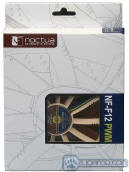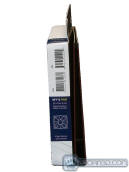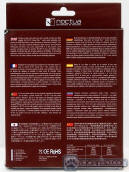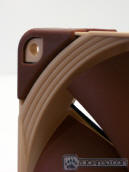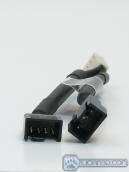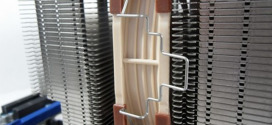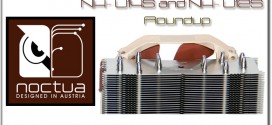Is a quiet fan strong enough to keep a CPU cool? Noctua believes that with its unique features this one is, so we will endeavor to find out if that belief is justified.
Introduction
Cooling system components are of importance to every PC user, from those that run basic desktop apps, to those that push a system for all it’s worth. While stock cooling may be sufficient for web browsing and desktop applications on a basic system, a bit extra may be desired for high end systems running while overclocked and/or executing applications that max out the hardware.
To this end several companies offer aftermarket fans aimed at enhanced cooling. One of these is Noctua, an Austrian company whose goal is to provide effective, quiet cooling for the PC consumer market. Among their offerings is the NF-F12 “Focused Flow” PWM fan which we will be examining today.

This product claims many unique features all aimed at making it quiet and still capable of keeping things cool, so let us take a closer look at it and see if it meets those claims.
The Noctua NF-F12 PWM is available from many online retailers at prices ranging from $18 to $40+ USD.
Features & Specifications
Features
The above feature chart outlines the many differences between this and traditional fans. Several features we see and would like to see from other manufacturers include the 6 year warranty, and cabling options. The low noise adaptor is another feature that Noctua’s competition should pay attention to. We won’t go so far as to recommend copying the fans truly unique features.
Specifications
| Size | 120x120x25 mm | |
| Connector | 4-pin PWM | |
| Bearing | SSO2 | |
| Blade Geometry | Heptaperf™ | |
| Frame Technology | Focused Flow™ | |
| Rotational Speed (+/- 10%) | 1500 RPM | |
| Rotational Speed with L.N.A. (+/- 10%) | 1200 RPM | |
| Min. Rotational Speed (PWM) | 300 RPM | |
| Airflow | 93,4 m³/h | |
| Airflow with L.N.A. | 74,3 m³/h | |
| Acoustical Noise | 22,4 dB(A) | |
| Acoustical Noise with L.N.A. | 18,6 dB(A) | |
| Static Pressure | 2,61 mm H2O | |
| Static Pressure with L.N.A. | 1,83 mm H2O | |
| Max. Input Power | 0,6 W | |
| Max. Input Current | 0,05 A | |
| Voltage | 12 V | |
| MTBF | > 150.000 h | |
| Scope of Delivery |
|
|
| Warranty | 6 years | |
For the specs let’s talk about the ones that really matter to us as end users: noise and airflow.
93.4 CMH translates to 54.9 CFM, which is a fairly respectable flow. Please try to keep in mind that to get a lot of airflow requires making a lot of noise. At 72 CFM the average fan generates enough sound to be heard across a room. The 22.4 dB (A) listed here is quieter than a ticking wristwatch. With the use of the included Low-Noise Adaptor this decibel level can be further reduced, but at the cost of airflow.
Pictures & Impressions
The front of the package is simple and attractive utilizing a line drawing of the product overlaid by the company logo at the top corner and featuring a a cut-out bordered with blue displaying the product name allowing consumers a view of the fan inside. The only side with any information on it is to the right of the front. it contains the UPC and EAN codes lists the product name and dimensions informs us that the product meets ISO9001 & ISO14001 specs, that it has a 6 year warranty and lists the company web address. The back of the box features a concise description of the product in eight languages. It is attached with Velcro to the package at one corner letting perspective buyers open it to see a detailed breakdown of the design features spanning four pages.
Once opened we see that the contents are help in a plastic shell and a user’s manual is included. Removing the various pieces we find the fan, a package of four fan screws, four rubber nails, an extension cable, the Low Noise Adaptor, and a Y cable allowing the use of 2 PWM fans from a single motherboard connector.
The exhaust/frame side of this fan is unusual looking due to the “Vortex Control Notches” cut into the ‘Stator Guide Vanes” (another unusual feature) which are spaced unevenly on purpose (diagram of angles shown above) the purpose of these measures is to ” to spread the noise emission over a broader frequency spectrum and thus make the fan’s sound pattern more agreeable to the human ear”. The stepped inlet design facilitates airflow while helping to reduce “tonal intake noise”. We aren’t sure if this means that is changes the tone of the sound, reduces the overall noise level, or both.
The Frame has re-enforcement engineered into it making it strong enough that even when an effort is applied the frame doe not flex enough to be worth mentioning. The rubber anti vibration pads are mounted to each corner with a built in rubber pin and very secure. They are quite easy to remove if one so desires although we cannot see any good reason for doing so. Two of the images give readers a better look at the “Vortex Control Notches”. We also included a shot of the Y- connector to show that it is indeed a full PWM connection for two fans.
We would have included images of the “Inner Surface Microstructures” but quite frankly they are too small for the human eye, and the camera we are using just isn’t up to it.
Testing and Methodology
Testing of the Noctua NF-F12 PWM fan was as follows, it and the fans it was tested against, were mounted to an Evercool Transformer 3 CPU cooler in an open case. This keeps the variables constant across the testing period. The AMD Phenom 9500 CPU was overclocked from the stock 2.2GHz to 2.5GHz. To generate as much heat as possible we ran a Prime95 torture test consisting of In place large FFT’s, maximum heat, power consumption, some RAM tested, which places a 100% load on the CPU.
Each round of testing was accomplished by allowing the system to idle for 20 minutes, reading the temps, then running at full load for 30 minutes and reading them again. Temperatures were obtained from HWiNFO64. Ambient temperature was kept at 23.3°C (74°F)
The fans used for comparison are the Thermaltake Silentcat, the Enermax TBSILENCE fixed rpm UTCB9, the SilenX EFX-12-12 and the stock fan included with the Transformer 3. Specifications for these fans are listed below. The Noctua NF-F12 PWM fan was tested both with and without the included Low Noise Adaptor.
| Test System | |
| Case | Cooler Master HAF 932 Advanced |
|
Processor |
AMD Phenom II X4 9500 (Agena)
|
| CPU cooler | Evercool Transformer 3 |
|
Motherboard |
Asus M3N-HT Deluxe (bios 3401) |
|
Memory |
4 GB Patriot 8500EL series PC2-6400 |
|
Drive(s) |
Maxtor 7H500F0, WDC WD 1600BEVT |
|
Graphics |
2 Nvidia GTX 480 referance in SLI, Gigabyte GTX 560 OC |
|
Power Supply |
Enermax Revolution87+ 1000 watt |
| Operating System | Windows 7 Ultimate 64bit |
| Case fans | Total 7 (excluding PSU fan), Two 230mm, One 140mm, Four 120mm (not used during testing) |
Results
| Tested fan specifications |
Rated RPM | Rated CFM | Rated dBA |
| Thermaltake Silentcat DC | 1600 | 62.2 | 16 |
| Enermax TBSilence PWM | 500-1500 (±10% | 26.51 – 71.25 | min 8, max not stated |
| Enermax TBSilence LED UCTB12N-R DC | 1200 (±10%) | 53.02 | 14 |
| Noctua NF-F12 PWM | 1500 | 54.9 | 22.4 |
| Noctua NF-F12 PWM w/ Low Noise Adaptor | 1200 | 43.75 | 18. |
The Noctua NF-F12 PWM fan is extremely quiet. At full rev, with all case fans off, and the video card fans turned down as far as possible, this fan was effectively inaudible at a distance of approximately 3ft/1M with the ambient sounds of the A/C system and other fairly quiet sound sources going on. To hear the fan required leaning toward the case to a distance of around 2ft, and even at that point it was very quiet. Without the Low Noise Adaptor installed, while off, the cooler the NF-F12 reached the full 1500 RPM and varied between 1486 and 1506 RPM once mounted to the Transformer 3. With the LNA installed, the RPM never went above 1106 and mostly fluctuated between 1088 and 1094 RPM.

As for the temperatures, it performs very well, actually performing as well as or better than fans with a higher CFM rating. Even though it did not reach the stated 1200 RPM with the LNA installed it still performed admirably and kept the CPU well under it’s thermal limit. We can only assume that the unique features of this fan, such as the focused flow, attributed to its success in these tests.
During these tests the rubber nails from the Transformer 3 were damaged. With a slight trim for width via Exacto knife, the ones included with the NF-F12 stood in quite nicely.
Using the included Y adapter and the Stock PWM fan from the Transformer 3, we discovered that only one branch of the Y reports RPM, and that with 2 fans connected there is a slight drop in RPM on the NF-F12 from the 1486 and 1506 RPM reported above to a range from 1418 to 1424 RPM. It should be noted that adding the second fan in a push/pull configuration dropped the load temp a full 2 degrees to 39.5 C
Conclusions
The Noctua NF-F12 was a nice surprise. We were expecting it to be like many of the other fans on the market today, making claims that they just barely cover, if at all. The NF-F12 claims it can cool as well or better than fans pushing more CFM, and do so with less noise. It claims right on the box that it “creates outstanding static pressure and focuses the airflow for superior performance”. During our tests it met those claims.
Noctua also made claims of “trusted premium quality”, this makes the assumption of prior experience with their products, and perhaps given the quality of this product we can allow them that bit of slightly arrogant assumption.
The extension & Y-cables, and Low Noise Adaptor are nice additions showing that Noctua thinks about more than just building fans, but also how and where they are going to be used. By including both screws and rubber anti-vibration mounting pins Noctua has created a whole package with this product allowing it to be used on radiators, heatsinks, or cases with with several options for mounting and connecting it.
This fan has so many features it would be hard to cover them in a conversation (we learned this the hard way) but they are all geared toward making this fan quieter and more efficient ant the same time. We can attest to the fact that they do just this. One feature we have to accept their word for is the custom PWM IC. It is to allow the fan to run quieter at low speeds by reducing the switching noise from the PWM circuit. The fan was so quiet that we aren’t sure if it was needed or not.
While we are always game to test another fan this one will be staying in what ever system we are running tests on until one comes along that can beat it for noise to performance ratio. We’re betting it will be in the system for a long while.
| OUR VERDICT: Noctua NF-F12 PWM fan | ||||||||||||||||||
|
||||||||||||||||||
| Summary: With a ton of features, a few unexpected extras, a killer warranty, superior quality, decent value, and performance that excels, the Noctua NF-F12 PWM is an exellent choice for a cooling fan. It easily earns the Bjorn3D Golden Bear Award. |
 Bjorn3D.com Bjorn3d.com – Satisfying Your Daily Tech Cravings Since 1996
Bjorn3D.com Bjorn3d.com – Satisfying Your Daily Tech Cravings Since 1996













